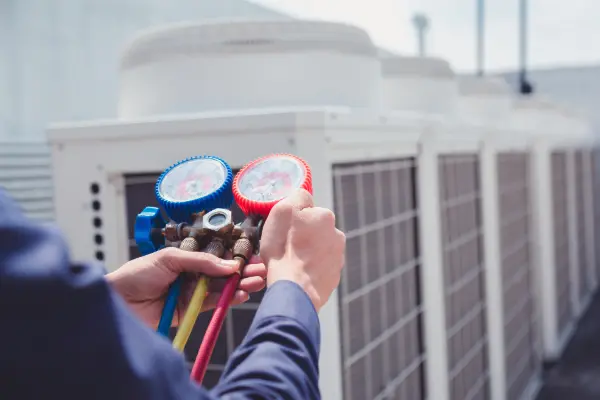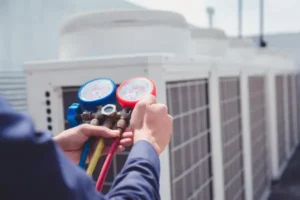The HVAC industry is undergoing a major change in 2025 with the EPA-mandated phase-out of R-410A refrigerant, affecting new equipment design, pricing, and compliance.
This transition—part of the EPA’s Technology Transitions Rule under the American Innovation and Manufacturing (AIM) Act—has big implications for facilities managers. The rule sets a GWP limit of 700 or less for most new HVAC systems, meaning that R-410A is no longer allowed in new equipment as of 2025.
What’s Replacing R-410A?
HVAC manufacturers have already shifted production toward a new generation of A2L refrigerants, which have lower GWP and comply with the new EPA guidelines. The most common of these include:
- R-454B (widely used in packaged units and split systems)
- R-32 (popular in ductless systems and select equipment)
These new refrigerants are more environmentally friendly—but the change comes with important planning and budgeting considerations.
What to Expect: Costs, Timelines, and Equipment
- Higher Equipment Prices: The switch to A2L refrigerants involves new manufacturing processes, safety standards, and components. On average, costs are expected to rise by 10–15% for new systems.
- Older Systems Can Still Be Serviced: If your building uses R-410A equipment, you can still maintain and repair it. However, R-410A will become more expensive and harder to source as production phases down.
- Supply Chain Adjustments: As the market adapts to new refrigerants, we’re seeing short-term supply issues with certain types of refrigerant and equipment. Early planning will help avoid project delays.
Strategic Steps for Facilities Managers
Whether you’re managing a private school, hospital, manufacturing plant, or lab, this transition is a chance to reassess your HVAC strategy. Here’s how to prepare:
1. Assess System Age and Performance
If your system is 15+ years old, now is the time to evaluate replacement options before prices rise further.
2. Budget for R-410A Cost Increases
For newer systems still running on R-410A, plan for rising refrigerant and repair costs in the next few years.
3. Extend System Life Through Maintenance
Keep your current systems running at peak performance with proactive maintenance—a key step to delay costly upgrades.
4. Consider Phased Upgrades
Can’t replace everything at once? Start with your most critical areas and create a phased roadmap aligned with your budget.
5. Stay Compliant and Informed
The EPA has not changed the 2025 timeline, but legal challenges and ongoing review may affect refrigeration equipment rules in the future. LC Anderson stays on top of these developments, so you don’t have to.
How LC Anderson Supports You
This refrigerant transition is more than just swapping out equipment. It affects compliance, capital planning, operational continuity, and your sustainability goals. That’s where LC Anderson comes in.
We provide:
- Thorough System Assessments to identify the smartest upgrade or maintenance path
- Customized Maintenance Plans to extend life and efficiency of existing systems
- Expertise in A2L refrigerants like R-454B and R-32, including safety and code compliance
- Capital Planning Support with multi-year strategies to manage your investments wisely
- Ongoing Education to keep facilities teams informed and prepared
Need help navigating your next project or planning ahead for replacements? We’re always here to help. Contact us today
Editor’s Note: This article was updated in July 2025 to reflect the latest EPA regulations and industry developments regarding refrigerant transitions.



